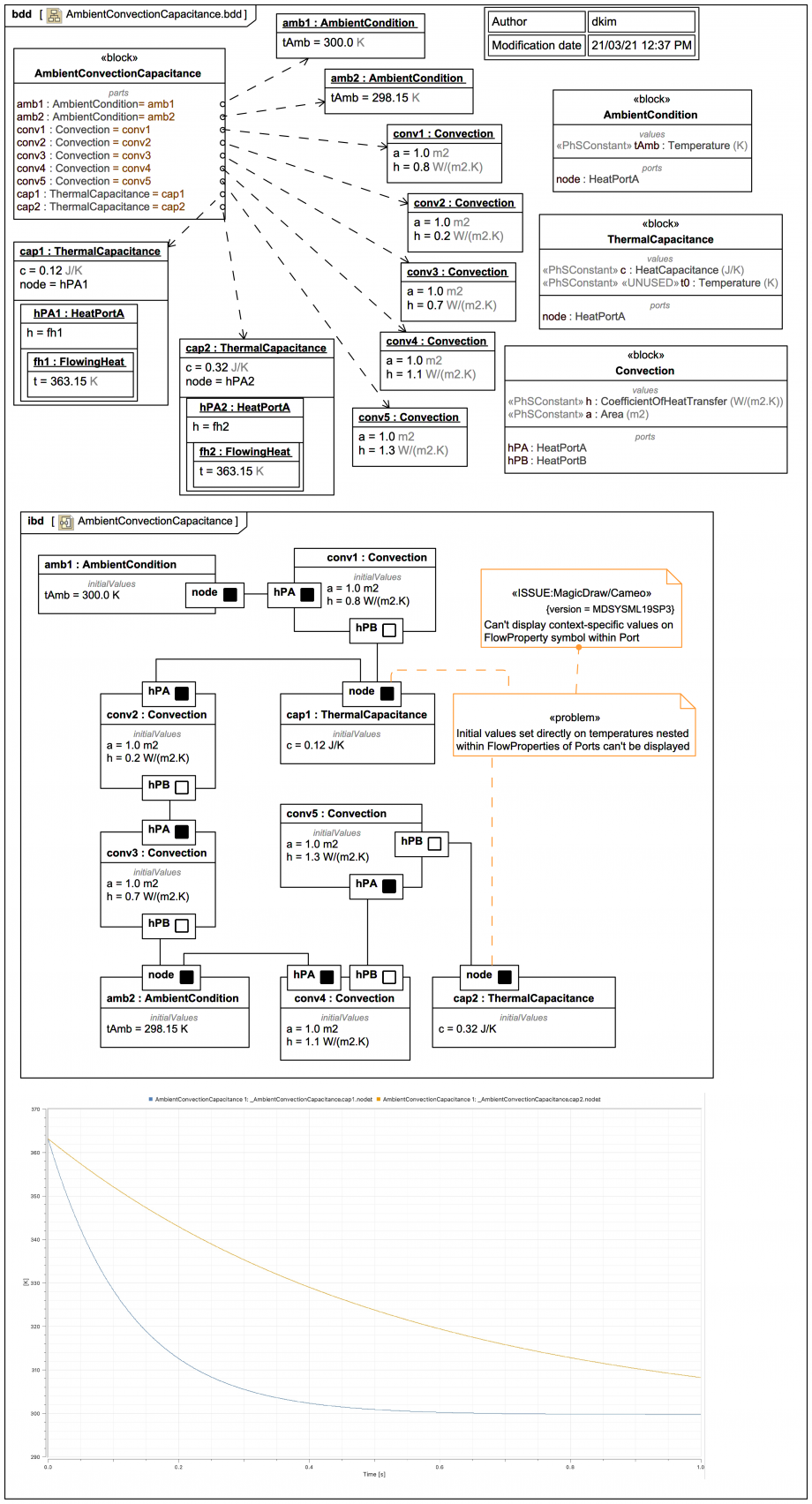Tags and keywords
The Modelica By Example target only shows as a patch figure and a plot towards the bottom of the page (there is no Modelica code shown).
Multiple usages of different components defined in previous slide diagrams are combined in this trail in a block AmbientConvectionCapacitance, which exports via SysPhS to Modelica as:
model AmbientConvectionCapacitance
AmbientConvectionCapacitance _AmbientConvectionCapacitance;
model AmbientConvectionCapacitance
AmbientCondition amb1(tAmb.start=300.0,tAmb.fixed=true);
AmbientCondition amb2(tAmb.start=298.15,tAmb.fixed=true);
Convection conv1(a.start=1.0,a.fixed=true,h.start=0.8,h.fixed=true);
Convection conv2(a.start=1.0,a.fixed=true,h.start=0.2,h.fixed=true);
Convection conv3(a.start=1.0,a.fixed=true,h.start=0.7,h.fixed=true);
Convection conv4(a.start=1.0,a.fixed=true,h.start=1.1,h.fixed=true);
Convection conv5(a.start=1.0,a.fixed=true,h.start=1.3,h.fixed=true);
ThermalCapacitance cap1(c.start=0.12,c.fixed=true,node.t.start=363.15,node.t.fixed=true);
ThermalCapacitance cap2(c.start=0.32,c.fixed=true,node.t.start=363.15,node.t.fixed=true);
equation
connect(amb1.node,conv1.hPA);
connect(conv1.hPB,cap1.node);
connect(cap1.node,conv2.hPA);
connect(conv2.hPB,conv3.hPA);
connect(conv3.hPB,amb2.node);
connect(conv4.hPB,conv5.hPA);
connect(amb2.node,conv4.hPA);
connect(conv5.hPB,cap2.node);
end AmbientConvectionCapacitance;
model AmbientCondition
HeatPortA node;
parameter Temperature tAmb;
equation
node.t=tAmb;
end AmbientCondition;
model Convection
parameter CoefficientOfHeatTransfer h;
parameter Area a;
HeatPortA hPA;
HeatPortB hPB;
equation
hPA.hFR+hPB.hFR=0;
hPA.hFR=h*a*(hPA.t-hPB.t);
end Convection;
model ThermalCapacitance
parameter HeatCapacitance c;
parameter Temperature t0;
HeatPortA node;
equation
c*der(node.t)=node.hFR;
end ThermalCapacitance;
connector HeatPortA
extends HeatFlowElement;
end HeatPortA;
connector HeatPortB
extends HeatFlowElement;
end HeatPortB;
connector HeatFlowElement
flow HeatFlowRate hFR;
Temperature t;
end HeatFlowElement;
type Temperature=Real(unit="K");
type CoefficientOfHeatTransfer=Real(unit="W/(m2.K)");
type Area=Real(unit="m2");
type HeatCapacitance=Real(unit="J/K");
type HeatFlowRate=Real(unit="J/s");
end AmbientConvectionCapacitance;
t deep within the Port of each ThermalCapacitance, which is achieved using an instance tree for Context-Specific Values, which is a bit fiddly. The Dependencies from the parts to the instances and instance trees that define the 'start' values are just for illustration.
Unfortunately, a minor tool matter means these Context-Specific Values as applied can't be displayed in the Internal Block Diagram (IBD):
There's a minor inconsistency in the Modelica By Example treatment of Convection. The patch diagrams show only the coefficient of heat transfer h as a variable, the area a is not given, but in the Modelica By Example code the area a is a variable, not a parameter (so not a PhSConstant), and in the Modelica By Example code overrides are always provided, like this:
Convection convection(h=0.7, A=1.0)
Convection, which is WET not DRY. One could instead define a shared direct default of 1.0 on the area a within Convection.
Finally, the plot of the temperature on the Ports of each ThermalCapacitance as shown (computed in Wolfram SystemsModeler) looks a tiny bit different from the one shown on the Modelica By Example page.


